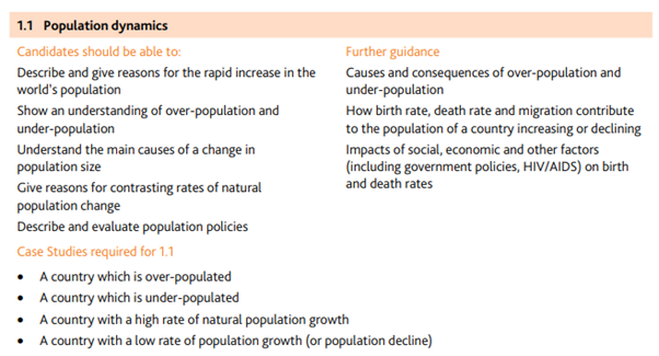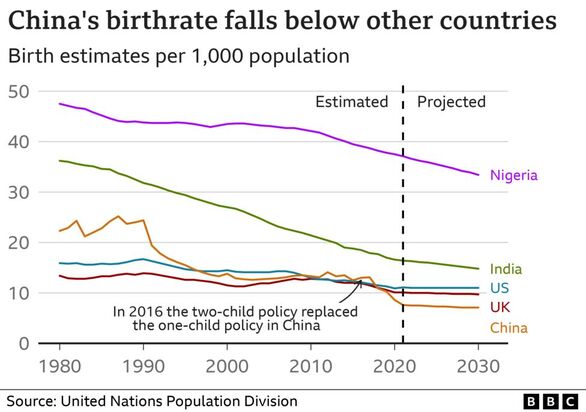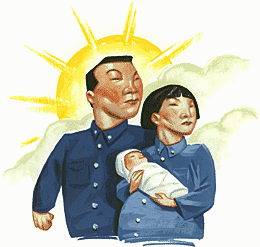|
As you will see from the list above, there are four case studies in section 1.1 Population. A case study is important in Paper 1 as the 7-mark essay question in the Population section will be based on a case study. It is important that you have clear and detailed notes on the case study to include, place, people, processes and data.
You will see the location of these case studies on this page when you see the GIF logo to the right. |
Global Population & Me!
To kick off this unit on population, we're going to be taking a look at this amazing site.
Load up the page and then enter your date of birth and country of origin. Follow the instructions on the task sheet below to find out about your potential life expectancy and how that varies around the world. Are you ready to know you potential death date?
Load up the page and then enter your date of birth and country of origin. Follow the instructions on the task sheet below to find out about your potential life expectancy and how that varies around the world. Are you ready to know you potential death date?
Who Is This?
Task 1 - Study the face above. On your worksheet, write down who you think this person is and perhaps write a little bit about him/her.
What nationality?
What age?
Which gender?
How you know this person - because you've all met him/her?
Why is the image so grainy?
What nationality?
What age?
Which gender?
How you know this person - because you've all met him/her?
Why is the image so grainy?
Task 2 - Watch the first video below noting down as many facts as possible on the face worksheet in task 1.
Discuss the issues that are most important to us today. Will life be the same in 100 years from now? What might change?
Task 3 - Now watch the second video below that charts the global population growth. Some of you may have seen this before.
Task 4 - You will be completing a piece of work from geographyalltheway.com.
Click here to be taken to the relevant section of the site.
Complete your answers on the worksheet below.
To find out the population when you were born on the worksheet above, click here!
Task 5 - Google Research Time - What are the causes and effects of rapid population growth.
Complete the worksheet below, following the tasks that are set out.
|
|
|
How Many People Can Live on Planet Earth?
Task 6 - Watch the 45 minute video by clicking on the image above - How Many People Can Live on Planet Earth?
Use the work sheet above to complete the activities during the video. The activities are in chronological order.
Print out the sheet and work on it in front of the computer/TV as you watch the documentary.
What Causes a High Birth Rate?
Starter: Click here to be taken to Baby O Matic, using the GATW site. Complete the first activity.
The United Nations typically measures maternal fertility of nations by using birth rate, defined by the number of births per 1,000 women of child-bearing age.
Birth rates can be high in LIC/LEDC's high because:
- Children are needed to work and bring in an income for the family.
- Children are required to look after elderly parents because of a lack of pensions.
- Lack of availability and knowledge of contraception and family planning.
- High infant mortality rates, so parents have more children in the hope that some survive.
- Religious beliefs– certain religions encourage large families
What Causes a High Death Rate?
Death rates can be be high in LIC/LEDC's because of:
- Lack of food caused by famine.
- Malnutrition caused by poor diet.
- Poor sanitation and lack of clean drinking water.
- Natural disasters destroying crops.
- High levels of disease, eg malaria.
- Lack of doctors, medicines and healthcare.
- War, e.g. Ukraine
Complete the tasks set out on the worksheet below
What Causes Population Growth To Slow?
Make a note of the following reasons that can contribute towards population growth.
1. Contraception - People are now able to choose when to have children (family planning)
2. Lower fertility rates - Parents realise that their children will survive past their first birthday due to medical advancements
3. Anti-Natalist policies - The former 'One Child Policy' in China aimed at cutting the fertility rate to below 2
4. Career Women - Now deciding to postpone starting family to focus on forging a career path and earning money
5. Children cost a lot! - It can cost upwards of $200,000 to bring up a child until they turn 18 years old!
Objective: To show an understanding of the factors that lead to the under and over population of two contrasting countries.
Starter: Spend 5 minutes playing with this super 3D mapping visualisation that shows the most densely population parts of planet. Fly over Bangladesh & Australia to contrast both places.
|
Overpopulation is when there is not enough resources for the inhabitants in an area. Inevitably this leads to famine, water and electricity shortages, increased unemployment.
Class Activity - Brainstorm the issues that may arise because of overpopulation in Bangladesh. Use the worksheet below. |
Under population is when there is more resources than inhabitants in an area. Surplus in food and water results in wastes. Societal systems such as schools and hospitals will then not have enough demand to run at a sustainable level. So the cost per capita for the service will increase.
Class Activity - Brainstorm the issues that may arise because of underpopulation in Australia. Use the worksheet below. |
Optimum population is when there is enough resources for the number of inhabitants (population demand for goods is equal to the supply). The optimum population will also be influenced by developments in technology, demographic structure changes, as trade opportunities develop/falter, and as new raw materials are discovered to replace old ones which are exhausted or whose values change over time
Task 1 - Using the theory above (taken from Cool Geography and Revise Geography Weebly), work in pairs to create two separate infographics with Piktochart, Powerpoint or Canva to show the causes and effects of both overpopulation on Bangladesh and under population on Australia.
Exam Corner:
Using a named example, explain how the relationship between population and resources can cause overpopulation/underpopulation. [7 Marks ]
|
Task 1 - Focus - Nigeria & Africa - Download and listen to the BBC Podcast above (23 minutes)
There are four parts to the podcast. Using the summary sheet above, summarise the message given by each of the four witnesses into the spaces provided.
Revision Review - Before revising this section, watch the video below to refresh you memory on this case study.
|
|
|
In this section, we will be covering two different sections of work from the syllabus at the top of this page. Firstly, we will be looking at the China One child Policy (describe & evaluation population policies) and then looking at how this had led to low levels of population growth.
Task 1 - What is the situation in China in 2023/24? Use this 2023 report from the BBC news to complete the note taking document below.
Extension Task for A*-C students - Read this 2023 article from the BBC News to understand the implications of a reduction in the population of China on the rest of the world.
Task 2 - Why do governments want to control the birth rate and how do they communicate this to their people?
i. You have five minutes to create your own slogan and poster to encourage (pro natalist) or discourage (anti natalist) the fertility rate of a population. BE CAREFUL!
Click here to be taken to a website that has some of the most famous policies and how they were 'advertised'.
ii. Choose three posters and copy them into this worksheet
iii. Annotate around each poster the message and how the government is trying to persuade their people to conform. Don't forget to explain what they are suggesting.
Task 2 - Why do governments want to control the birth rate and how do they communicate this to their people?
i. You have five minutes to create your own slogan and poster to encourage (pro natalist) or discourage (anti natalist) the fertility rate of a population. BE CAREFUL!
Click here to be taken to a website that has some of the most famous policies and how they were 'advertised'.
ii. Choose three posters and copy them into this worksheet
iii. Annotate around each poster the message and how the government is trying to persuade their people to conform. Don't forget to explain what they are suggesting.
Task 3 - - Study the graph above. Complete the Paper 1 type activities on the worksheet above. Here is the original source of the graph embedded above.
CHINA POPULATION POLICY (1979 - 2016) - THE ONE CHILD POLICY
An anti-natalist policy is concerned with limiting population growth by encouraging the population to have less children. The most famous example of this is in China and a policy called 'The One Child Policy'.
Task 4 - You are going to use the work of an ex-IGCSE Geography student to see if you can just use images to tell a story of the Chinese One Child Policy. You will be given a paper copy of the document below.
You have 20 minutes to work with a partner to try to work out the story of the One Child Policy, just using the infographic. You can annotate what you want around the graph and scribble any words or sentences down that you like. You will then feedback to the class with what you think it all means!
Task 5 - So, perhaps you did pretty well, or perhaps were well off the story! Time to get your story straight and you will need to access this Geofile issue 717 from Oxford University Press.
Make some brief notes to accompany your infographic. You might want to use the structure below to help you out.
- WHAT was the One Child Policy?
- WHERE was the One Child Policy used? This section should include a map and a location description
- WHEN was the policy introduced? This section should be sequenced in chronological order
- WHY was the policy introduced? Here you should explain why the Chinese authorities introduce the policy.
- WHO was affected by the policy?
- HOW was the policy implemented? In this section you should describe and explain the methods that were used by the authorities to ensure people follow the policy.
- SUCCESSES and FAILURES of the One Child Policy. Make reference to:
- Prevention of 400 million births
- The 4-2-1 problem
- What is the Little Emperor Syndrome?
- Research the 'Spare Branches' problem
Review: Population Key Words & Definitions
Objective: To recognise and define six key population terms and to be able to use the CIA World Fact Book to search for up to date and reliable data.
|
Task 1 - Open the worksheet on the right. Copy and complete the relevant definitions into place as well as using the link provided to find out key data for France (western Europe) and the Sierra Leone (western Africa) |














